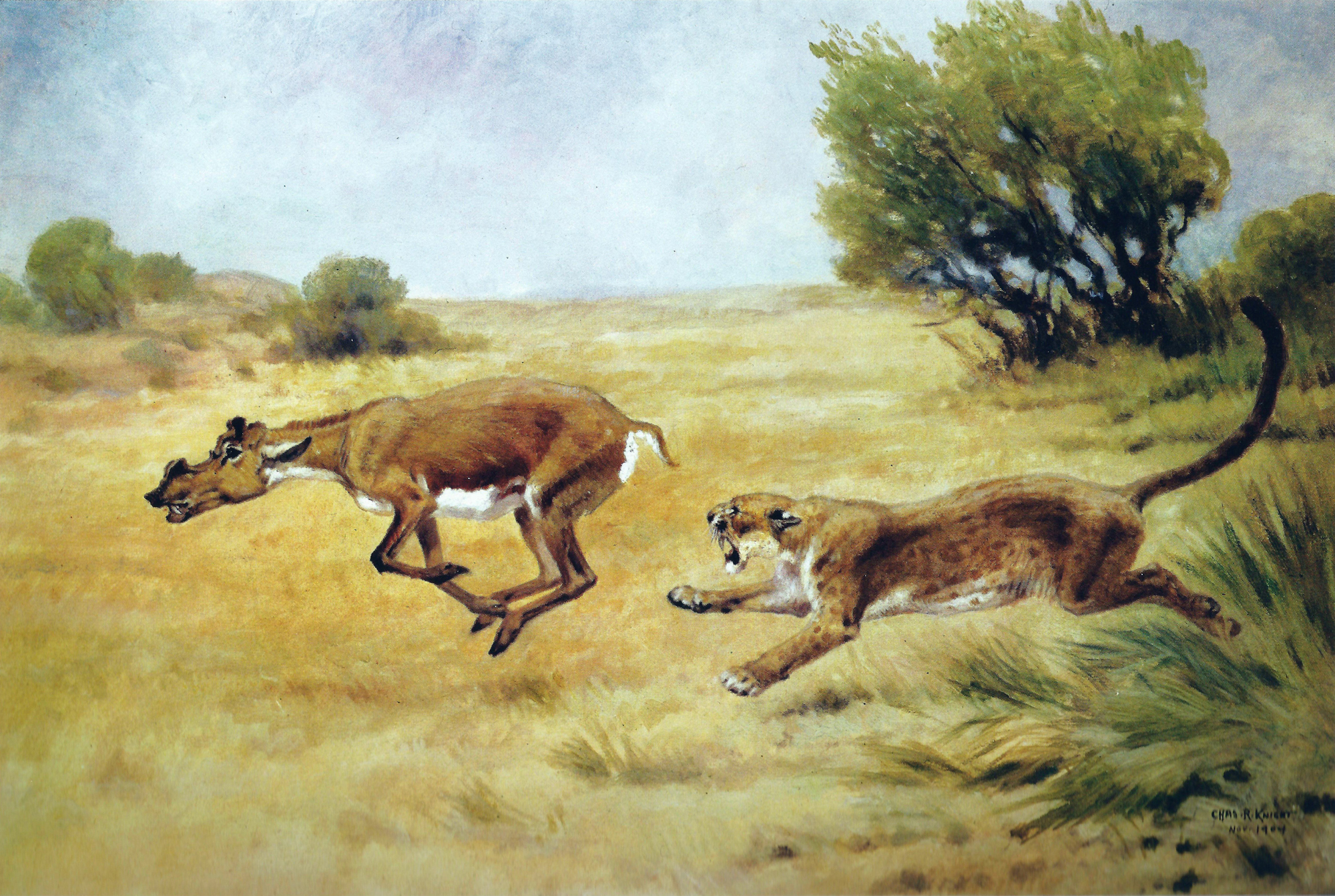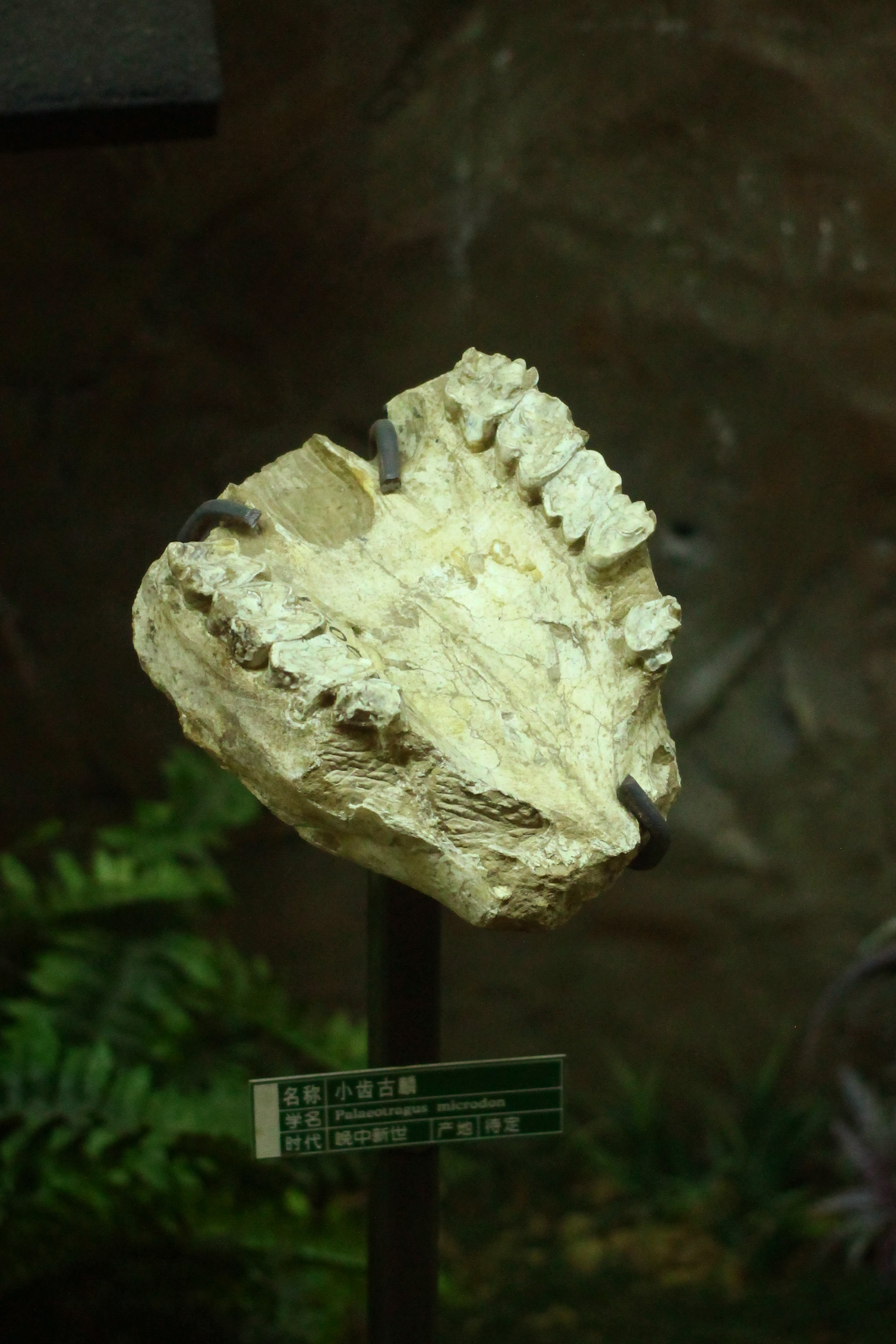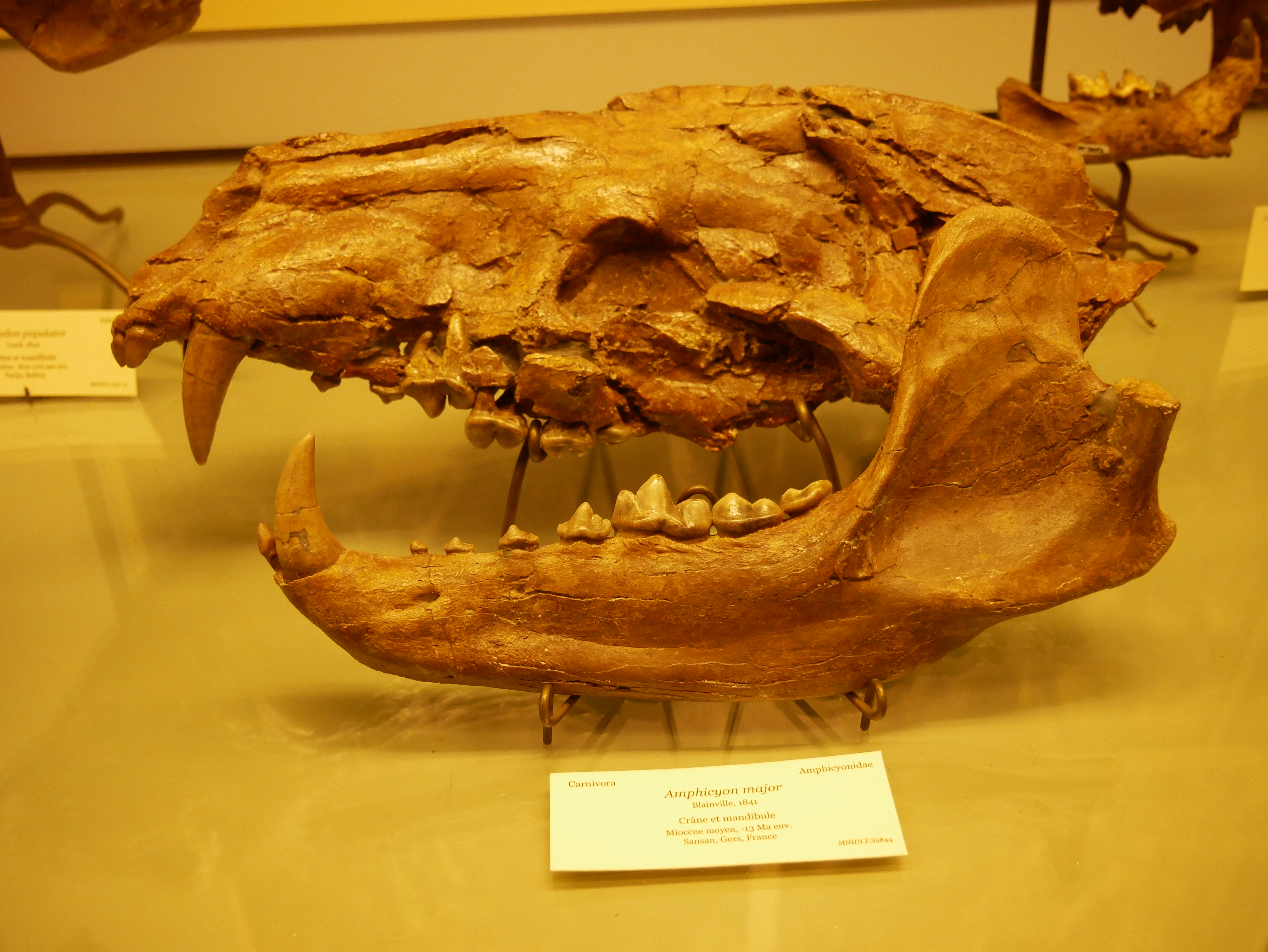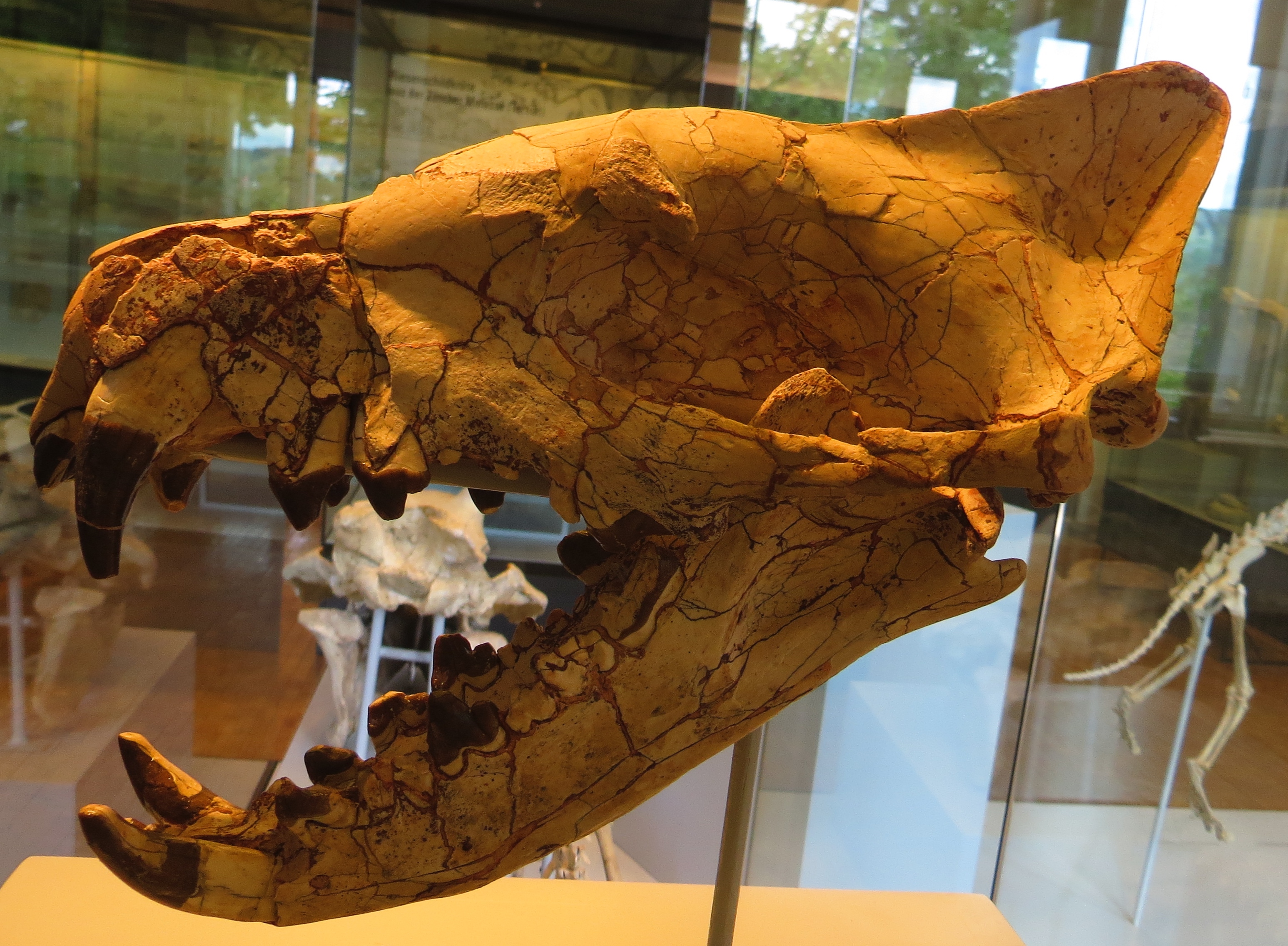|
Myacyon
''Myacyon'' is an extinct genus of large sized carnivoran mammals, belonging to the family Amphicyonidae (“bear dogs”), that lived in Africa during the Miocene epoch. Due to the limited scope and fragmentary nature of the severely damaged holotype, as well as the illustrations in its descriptions, which have been called inadequate, usage of this genus poses serious issues. However, it is notable for being one of the last surviving members of its family and its adaptions to hypercarnivory. Its relationships to other amphicyonids are obscure, and it is not closely related to '' Bonisicyon'', the other late surviving African genus, although it has been proposed that it descends from a species of ''Cynelos''. History and species The genus was erected in 1992 on the basis of a severely damaged and fragmented distal half of a right mandible containing m1-m2, and a not yet erupted m3, found at the locality Oued Mya in Algeria. In 2005, the species ''Agnotherium kiptalami'' was desc ... [...More Info...] [...Related Items...] OR: [Wikipedia] [Google] [Baidu] |
Agnotherium
''Agnotherium'' is a genus of large sized carnivoran mammals, belonging to the Amphicyonidae ("bear dogs"), which has been found in Western Europe, and possibly Northern Africa, and lived during the Late Miocene epoch. Despite only being known from fragmentary remains, the genus notable for hypercarnivorous adaptions, which have been said to represent the "apex" among its family.Morlo M, Bastl K, Habersetzer J, Engel T, Lischewsky B, Lutz H, von Berg A, Rabenstein R, Nagel D. 2020The apex of amphicyonid hypercarnivory: solving the riddle of Agnotherium antiquum Kaup, 1833 (Mammalia, Carnivora).Journal of Vertebrate Paleontology 39(5):e1705848 DOI 10.1080/02724634.2019.1705848. History and naming The genus ''Agnotherium'' was created by Johann Jakob von Kaup, based on a single molar (HLMD Din 1143) found in the Eppelsheim Formation, more well known as Dinotheriensande, located in southwestern Germany. Kaup, who described many Eppelsheim mammals, including such famous ones as ''D ... [...More Info...] [...Related Items...] OR: [Wikipedia] [Google] [Baidu] |
Amphicyonidae
Amphicyonidae is an extinct family of terrestrial carnivorans belonging to the suborder Caniformia. They first appeared in North America in the middle Eocene (around 45 mya), spread to Europe by the late Eocene (35 mya), and appear in Asia, and Africa by the early Miocene (23 mya). They had largely disappeared worldwide by the late Miocene (8 mya), with the latest recorded species at the end of the Miocene in Pakistan. They were among the first carnivorans to evolve large body size. Later in their history, they came into competition with hesperocyonine and borophagine canids. As dogs evolved similar body sizes and cranial and dental adaptations, the rise of these groups may have led to their extinction. Amphicyonids are often colloquially referred to as "bear-dogs". Taxonomy The family was erected by Haeckel (1886) lso attributed to Trouessart (1885) Their exact position has long been disputed. Some early paleontologists defined them as members of the family Canidae, but ... [...More Info...] [...Related Items...] OR: [Wikipedia] [Google] [Baidu] |
Ngorora Formation
The Ngorora Formation is a geological formation in Kenya preserving fossils dating to the Miocene. The uppermost member of the formation shows sign of a faunal turnover that occurred around 11 to 10.5 million years ago, coinciding with faunal changes elsewhere in the world. This turnover includes the arrival of the horse ''Hipparion'' in East Africa. The Ngorora Formation was initially mapped by G.R. Chapman in collaboration with the East African Geological Research Unit (EAGRU) and formally described by Bishop & Chapman in 1970. Major fossil finds were made in the early 1970s, with expeditions to the area recovering thousands of mammal, fish and mollusc remains alongside less common fossil material of birds and reptiles. Geography The formation is bordered to the west by the Elgeyo Escarpment, the east by the Laikipia Plateau and to the north by the Tiati volcanic center. To the south the formation is limited by the rising floor of the rift. During its deposition the formation ... [...More Info...] [...Related Items...] OR: [Wikipedia] [Google] [Baidu] |
Middle Miocene
The Middle Miocene is a sub-epoch of the Miocene Epoch made up of two stages: the Langhian and Serravallian stages. The Middle Miocene is preceded by the Early Miocene. The sub-epoch lasted from 15.97 ± 0.05 Ma to 11.608 ± 0.005 Ma (million years ago). During this period, a sharp drop in global temperatures took place. This event is known as the Middle Miocene Climate Transition. For the purpose of establishing European Land Mammal Ages The European Land Mammal Mega Zones (abbreviation: ELMMZ, more commonly known as European land mammal ages or ELMA) are zones in rock layers that have a specific assemblage of fossils (biozones) based on occurrences of fossil assemblages of Europe ... this sub-epoch is equivalent to the Astaracian age. External links GeoWhen Database - Middle Miocene .02 02 * * {{geochronology-stub ... [...More Info...] [...Related Items...] OR: [Wikipedia] [Google] [Baidu] |
Nimravidae
Nimravidae is an extinct family (biology), family of carnivorans, sometimes known as false saber-toothed cats, whose fossils are found in North America and Eurasia. Not considered to belong to the true cats (family Felidae), the nimravids are generally considered closely related and classified as a distinct family in the suborder Feliformia. Fossils have been dated from the Middle Eocene through the Late Miocene epochs (Bartonian through Tortonian stages, 40.4–7.2 million years ago), spanning about . The barbourofelids, which were formerly classified as a subfamily of the Nimravidae, were reassigned to their own distinct family Barbourofelidae in 2004. However, some recent studies suggest the barbourofelids are a branch of the nimravids, suggesting that this debate might not be settled yet. Morphology and evolution Most nimravids had muscular, low-slung, cat-like bodies, with shorter legs and tails than are typical of cats. Unlike extant taxon, extant Feliformia, the nimravids ... [...More Info...] [...Related Items...] OR: [Wikipedia] [Google] [Baidu] |
Diastema
A diastema (plural diastemata, from Greek διάστημα, space) is a space or gap between two teeth. Many species of mammals have diastemata as a normal feature, most commonly between the incisors and molars. More colloquially, the condition may be referred to as gap teeth or tooth gap. In humans, the term is most commonly applied to an open space between the upper incisors (front teeth). It happens when there is an unequal relationship between the size of the teeth and the jaw. Diastemata are common for children and can exist in adult teeth as well. In humans Causes 1. Oversized Labial Frenulum: Diastema is sometimes caused or exacerbated by the action of a labial frenulum (the tissue connecting the lip to the gum), causing high mucosal attachment and less attached keratinized tissue. This is more prone to recession or by tongue thrusting, which can push the teeth apart. 2. Periodontal Disease: Periodontal disease, also known as gum disease, can result in bone loss that ... [...More Info...] [...Related Items...] OR: [Wikipedia] [Google] [Baidu] |
Hipparion
''Hipparion'' (Greek, "pony") is an extinct genus of horse that lived in North America, Asia, Europe, and Africa during the Miocene through Pleistocene ~23 Mya—781,000 years ago. It lived in non-forested, grassy plains, shortgrass prairie or steppes. Morphology ''Hipparion'' resembled the modern horse, but still had two vestigial outer toes (in addition to its hoof The hoof (plural: hooves) is the tip of a toe of an ungulate mammal, which is covered and strengthened with a thick and horny keratin covering. Artiodactyls are even-toed ungulates, species whose feet have an even number of digits, yet the rumin ...). In some species, these outer toes were functional. ''Hipparion'' was about tall at the shoulder. Species References {{Taxonbar, from=Q971275 Cenozoic mammals of Asia Cenozoic mammals of North America Miocene horses Pliocene horses Pleistocene horses Miocene genus first appearances Pleistocene genus extinctions Cenozoic mammals of Europe Cenozoic ma ... [...More Info...] [...Related Items...] OR: [Wikipedia] [Google] [Baidu] |
Aceratherium
''Aceratherium'' (Greek: "without (a) horn" (keratos), "beast" (therion)) was a genus of rhinoceros of the subfamily Aceratheriinae that lived in Eurasia during the Miocene. Taxonomy ''Aceratherium'' was coined by Kaup (1832) for ''"Rhinoceros" incisivum'' Cuvier, 1822 on the basis of the similarity of two skulls from Eppelsheim, Germany to the holotype incisor tooth from Weisenau in dental structure. However, the tooth from Weisenau has been recognized as belonging to a member of Teleoceratini, although the name ''Aceratherium'' has been widely used for the Eppelsheim skulls. Traditionally, many species have been referred to ''Aceratherium'' on the basis of them being hornless, turning the genus into a wastebasket. Revisions over the years have removed most species to the point that there are now only three valid species generally recognized (''A. incisivum'', ''A. depereti'', and ''A. porpani''). Description ''Aceratherium'' reached in length, a height of about and a weigh ... [...More Info...] [...Related Items...] OR: [Wikipedia] [Google] [Baidu] |
Palaeotragus
''Palaeotragus'' ("ancient goat") is a genus of very large, primitive, okapi-like giraffids from the Miocene of Africa and Eurasia. ''Palaeotragus primaevus'' is the older species, being found in early to mid-Miocene strata, while ''P. germaini'' is found in Late Miocene strata. ''P. primaevus'' is distinguished from ''P. germaini'' by the lack of ossicones. It was also the smaller species, being a little under at the shoulders. ''P. germaini'' had a pair of ossicones, and in life, it would have resembled either a short-necked, tall giraffe, or a gargantuan okapi. Species The genus consists of the following species: * ''Palaeotragus decipiens'' * ''Palaeotragus germaini'' * ''Palaeotragus microdon'' * ''Palaeotragus primaevus'' * ''Palaeotragus quadricornis ''Palaeotragus'' ("ancient goat") is a genus of very large, primitive, okapi-like giraffids from the Miocene of Africa and Eurasia. ''Palaeotragus primaevus'' is the older species, being found in early to mid-Miocene ... [...More Info...] [...Related Items...] OR: [Wikipedia] [Google] [Baidu] |
Proboscidea
The Proboscidea (; , ) are a taxonomic order of afrotherian mammals containing one living family (Elephantidae) and several extinct families. First described by J. Illiger in 1811, it encompasses the elephants and their close relatives. From the mid-Miocene onwards, most proboscideans were very large. The largest land mammal of all time may have been a proboscidean; ''Palaeoloxodon namadicus'' was up to at the shoulder and may have weighed up to , almost double the weight of some sauropods like ''Diplodocus carnegii''. The largest extant proboscidean is the African bush elephant, with a record of size of at the shoulder and . In addition to their enormous size, later proboscideans are distinguished by tusks and long, muscular trunks, which were less developed or absent in early proboscideans. Three species of elephant are currently recognised: the African bush elephant, the African forest elephant, and the Asian elephant. Elephantidae is the only surviving family of the or ... [...More Info...] [...Related Items...] OR: [Wikipedia] [Google] [Baidu] |
Amphicyon
''Amphicyon'' ("ambiguous dog") is an extinct genus of large carnivorous bone-crushing mammals, popularly known as bear dogs, of the family Amphicyonidae, subfamily Amphicyoninae, from the Burdigalian Epoch until the late Pliocene, with the creature having bear-like and dog-like features. They ranged over North America, Europe, Asia, and Africa from 16.9 to 2.6 Ma ago, existing for approximately . Morphology ''Amphicyon'' was the typical bear-dog amphicyonid with morphology similar to both bears and dogs. With its robust build and maximum length of 2.5 m (8 ft), the largest species looked more like a bear than a dog. It had a large heavy tail, thick neck, robust limbs and teeth like a wolf. It was probably an omnivore with a lifestyle comparable to that of the brown bear. The ''Amphicyon'' was very large for predators of its time but this advantage eventually became a disadvantage because its large body mass was too large to take faster prey. ''A. major'' has been est ... [...More Info...] [...Related Items...] OR: [Wikipedia] [Google] [Baidu] |
Hyaenodonta
Hyaenodonta (" hyena teeth") is an extinct order of hypercarnivorous placental pan-carnivoran mammals from mirorder Ferae. Hyaenodonts were important mammalian predators that arose during the early Paleocene in Europe and persisted well into the late Miocene. Characteristics Hyaenodonts are characterized by long skulls, slender jaws, slim bodies and a plantigrade stance. They generally ranged in size from 30 to 140 cm at the shoulder. While '' Simbakubwa kutokaafrika'' may have been up to (surpassing the modern polar bear in size) and ''Hyaenodon gigas'' (the largest species from genus ''Hyaenodon'') was as much as 1.4 m high at the shoulder, 3.0 m long and weighed about 330 kg, most of hyaenodonts were in the 5–15 kg range, equivalent to a mid-sized dog. The anatomy of their skulls show that they had a particularly acute sense of smell, while their teeth were adapted for shearing, rather than crushing. Because of their size range, it is probable that di ... [...More Info...] [...Related Items...] OR: [Wikipedia] [Google] [Baidu] |








